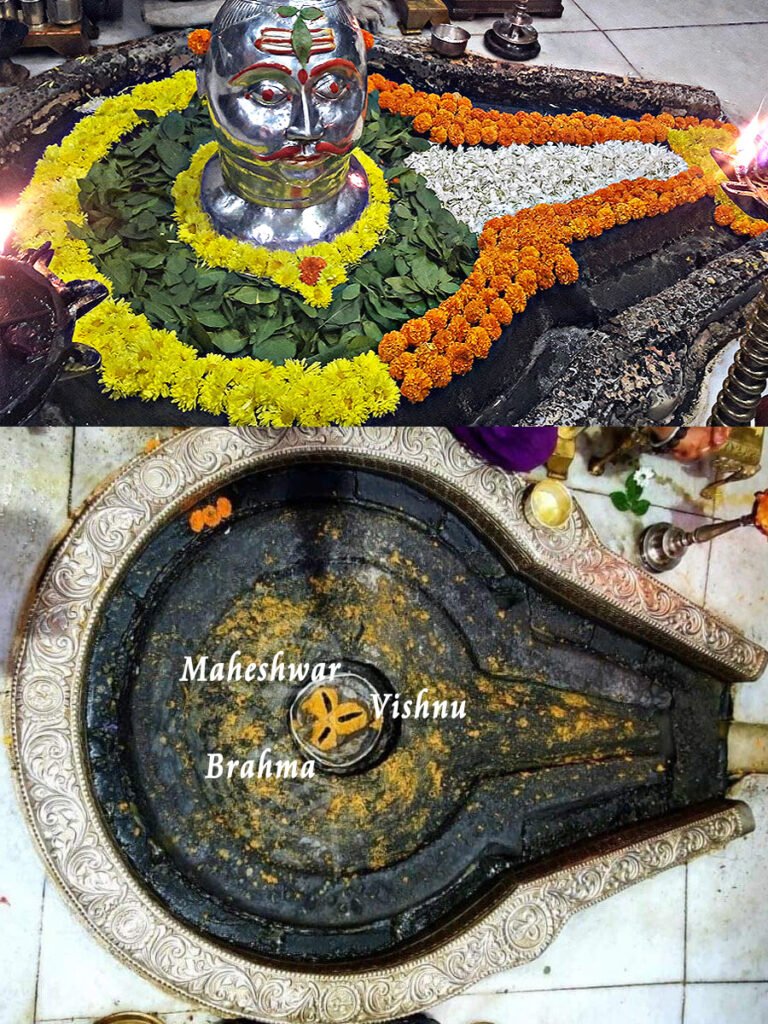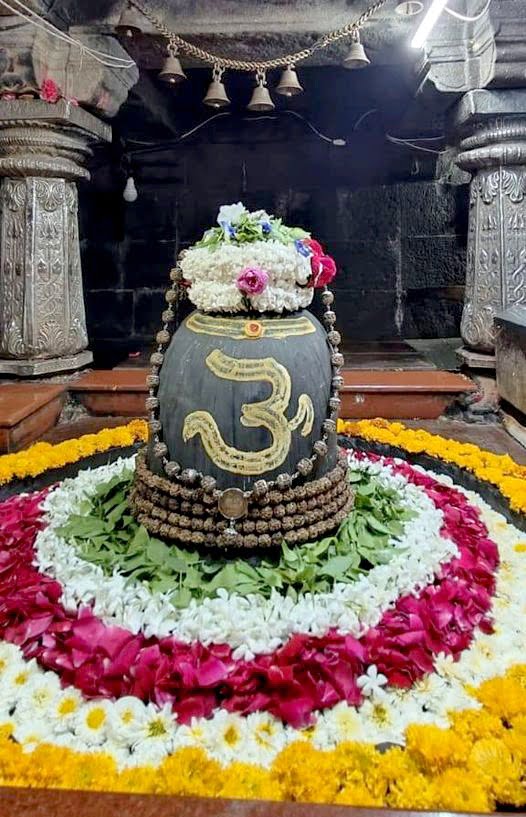Sri Bhoga Nandishwara Gudi: Famous 9 Century Nandi’s Abode
Today we’re embarking on a fantastic journey to a really, really old and magical site named Sri Bhoga Nandishwara Gudi. Picturize a great old book, but instead of pages, it’s formed by stone, and each carving is a story! This is not a regular temple; it’s more like a hidden garden where time stands still, and you can almost listen to the whispers of kings and queens from long, long ago. So let’s go inside this enchanted place, shall we?
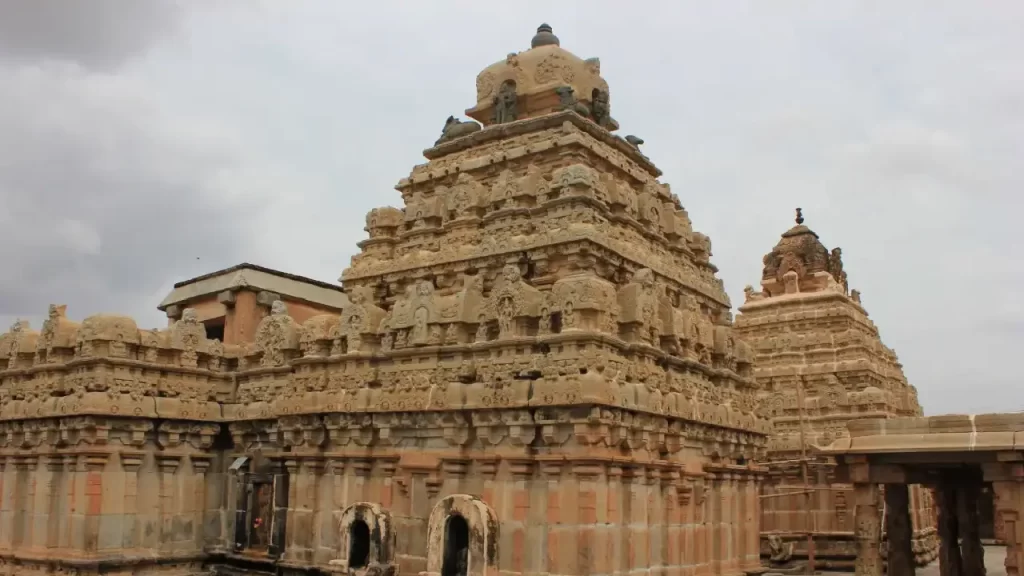
Contents
- 1 Welcome to Sri Bhoga Nandishwara Gudi: A Story Written in Stone!
- 2 Sri Bhoga Nandishwara Temple History:
- 3 The Amazing Tales of Lord Shiva: Legend of the Temple
- 4 Why This Place is So Special: Significance of the Temple
- 5 Carvings That Come Alive: Architecture of the Temple
- 6 Stories and Beliefs: Myths and Beliefs of the Temple
- 6.0.1 Nageshwar Jyotirlinga Dwaraka: 7th CE Temple with Divine Powers
- 6.0.2 Grishneshwar Temple: Wealth and Pleasure at Shiva’s Feet
- 6.0.3 Kedarnath Temple: One of Jyotirling & Char Dham
- 6.0.4 Trimbakeshwar Jyotirlinga Temple
- 6.0.5 Sacred Kashi Vishwanath Temple: 11th Jyotirling of Liberation
- 6.0.6 Aundha Nagnath Temple: 8th Jyothirling with Divine Serpents
- 7 Sri Bhoga Nandishwara Temple Timing:
- 8 More Adventures Nearby: Places to Visit Near the Temple
- 9 Your Journey to the Past: How to Reach the Temple
Welcome to Sri Bhoga Nandishwara Gudi: A Story Written in Stone!
Have you ever laid your eyes on a building that is so old it seems like it has a million tales to share? Well, the Sri Bhoga Nandishwara Gudi is just like that! It’s situated at the foot of the iconic Nandi Hills, which are like humongous green pillows stretching towards the sky. Picture a small seed that was planted hundreds of years ago, and it grew into this grand temple through the work of many hands over a long period of time.
It’s not only a location where humans pray; it’s a museum of time, where you get to see how kingdoms and artists once left their stamps. Every stone, every carving, every nook and cranny holds a secret. So, don your explorer hats, as we are about to lay bare some intriguing secrets!
Sri Bhoga Nandishwara Temple History:
Think of your grandpa sharing stories with you about his grandpa, and then his grandpa’s grandpa – that is how old this temple is! The Sri Bhoga Nandishwara Gudi began its journey long, long ago, over 1,200 years ago! Can you imagine that? That is even prior to your great-great-great-grandparents’ birth!
It was originally constructed by a kingdom named the Nolambas. They were extremely powerful kings who enjoyed creating beautiful structures. They placed the initial stones, and their mark is still visible in certain sections of the temple. But surprise, surprise! They were not alone!
The Nolambas followed, and after them other great kingdoms arrived and departed, each leaving something unique to Sri Bhoga Nandishwara Gudi, as one would add new pages in a great storybook. The Gangas contributed their own lovely sculptures. Then the great Cholas arrived, who were renowned for their magnificent temples, and made their own additions. Then came the Hoysalas, and they were master craftsmen, adding the most wonderful, detailed carvings that resemble lacework of stone! And last but not least, the Vijayanagara kings, who constructed a vast empire, left their imprint as well.
So, going around Sri Bhoga Nandishwara Gudi is walking through a timeline of various kingdoms, and each kingdom contributes its own style and beauty. It’s like a giant family album of Indian history, all at one go!
Read More>> Vittala Temple Hampi
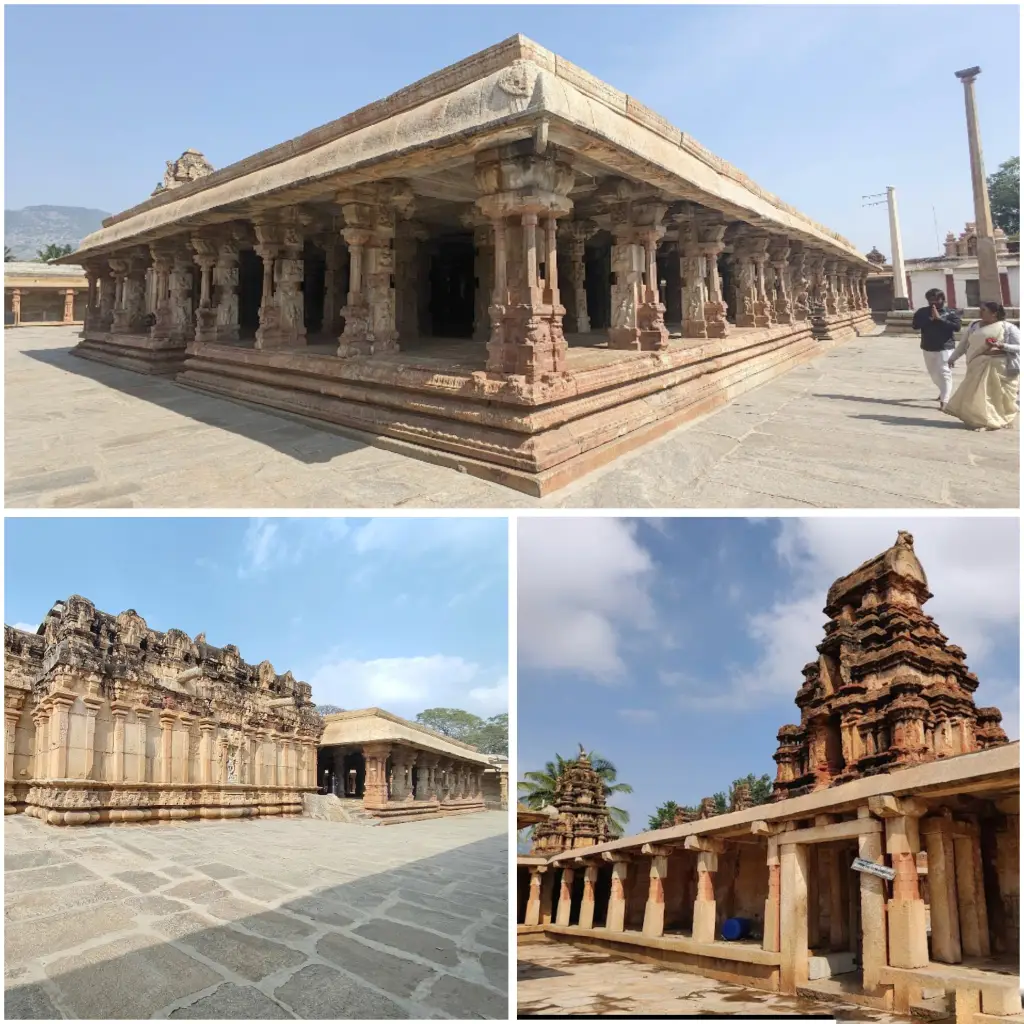
The Amazing Tales of Lord Shiva: Legend of the Temple
ll great temples have a tale, a legend that makes them even greater. The Sri Bhoga Nandishwara Gudi is about Lord Shiva, who is one of the most significant gods in Hinduism. But the best part is: this temple depicts Lord Shiva in various phases of his life, like a play!
Let us imagine Lord Shiva as a child, then as a joyful bridegroom, and again as a sage teacher. This temple has three major sections, and each of them relates to a different part of his life.
First, there’s the Bhoga Nandishwara shrine. “Bhoga” is an enjoyment or happiness. This area of the temple depicts Lord Shiva in his young, happy form, eager to celebrate! It’s where lots of happy festivals and celebrations take place. Imagine it as the party room of the temple!
Then there is the Arunachaleswara shrine. This one is a story of Lord Shiva’s childhood. It’s sort of like baby photos of a god! And funnily enough, this shrine houses a special figure of Lord Ganesha, who is the son of Shiva, but he is a wee bit scary-looking here, more like a lion, hence he is also referred to as Simha Ganapathi or Ugra Ganapathi. Don’t worry, he’s still very nice!
And lastly, the most sought-after section, particularly for adults who are getting married, is the Uma-Maheshwara shrine. This is where Lord Shiva marries Goddess Parvati! “Uma” is a synonym for Parvati, and “Maheshwara” is another name for Shiva. It’s a stunning, central section of the temple, and it has a unique hall known as the Kalyana Mantapa, or “wedding hall.” If you notice many people having their photos taken there, it’s likely because they recently got married and are searching for blessings to have a blissful life together!
So, the Sri Bhoga Nandishwara Gudi is technically not one temple, but three temples condensed into one, every one of them revealing a beautiful bit of Lord Shiva’s history!
Read More>> Kadri Shree Manjunatha Temple
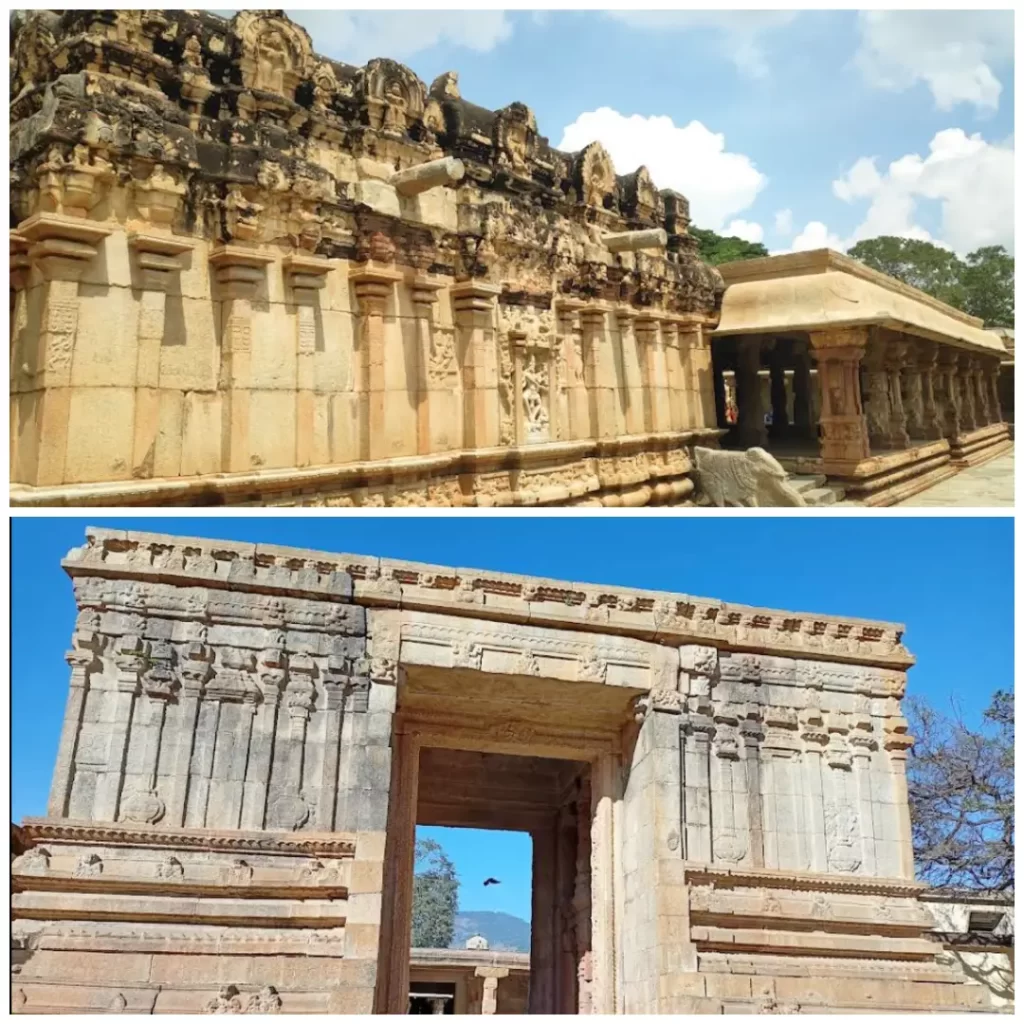
Why This Place is So Special: Significance of the Temple
The Sri Bhoga Nandishwara Gudi isn’t merely ancient; it’s incredibly significant for numerous reasons!
First of all, it’s a living museum of Indian architecture and art. Visualize an art class where various students from various schools painted on the same canvas for centuries. That’s what they did here! You can see the different styles of the Nolambas, Gangas, Cholas, Hoysalas, and Vijayanagaras, all mixed together. It’s a master class in temple construction!
Secondly, it’s a spiritual hub where many people feel that visiting this temple is good luck, and especially so for couples getting married. The Uma-Maheshwara sanctum is notably revered by newlywed couples, who visit the temple to seek blessings for a harmonious marriage. It’s a shrine where families gather and celebrate and seek blessings.
Thirdly, it teaches us about history. The temple walls have special markings known as “inscriptions” that are similar to ancient messages written by kings. These inscriptions inform us about the kings who constructed parts of the temple, what they achieved, and what life during those times was like. It is similar to a history book carved out of stone!
And then it’s a site of beauty and tranquility. Even if you don’t have time to read all the legends, just strolling around the serene courtyards, admiring the incredible carvings, and listening to birds sing, makes you very calm and contented. The Sri Bhoga Nandishwara Gudi is a real Indian gem.
Read More>> Sri Kukke Subramanya Temple: Lord of Serpents

Carvings That Come Alive: Architecture of the Temple
Now, let’s discuss how Sri Bhoga Nandishwara Gudi was constructed. It is not a stack of stones; it’s a work of art! The architecture style used here is primarily referred to as Dravidian architecture, which is prevalent in South India, but with a unique influence of the Hoysala style, which is renowned for its ridiculously intricate carvings.
Imagine a giant LEGO set, but instead of plastic bricks, it’s made of huge, heavy stones, and every piece is carved with tiny, intricate designs.
Amazing Carvings: Look closely at the walls and pillars. You’ll see statues of gods and goddesses like Lord Shiva, Goddess Parvati, Lord Vishnu, Goddess Lakshmi, Lord Brahma, Goddess Saraswathi, and many more! There are also carvings of animals, dancers, musicians, and scenes from old stories. It’s like a comic book cut out in stone! The Hoysala sculptors were particularly adept at this, so that their sculptures seemed almost lifelike. You can even spot minute details such as jewelry on the gods!
Special Windows (Jali): Observe the windows. They are not glass windows like the windows of your house. They are stone windows with very small holes drilled into them in intricate patterns. They are “jali.” They allow the cool breeze to enter and also cast beautiful patterns of light and shadow within the temple.
Pyramidal Towers (Shikharas): Observe the roofs of the central shrines. They are tall, pyramidal-shaped roofs. They are known as “shikharas.” They are frequently adorned with additional sculptures.
Nandi Mantapas: In front of every one of the major shrines, there is a unique open hall with a big, exquisitely carved statue of a bull. The bull is known as Nandi, and he is Lord Shiva’s faithful vehicle and companion. These halls are referred to as Nandi Mantapas. The statues of Nandi are always facing their lord.
Wedding Hall (Kalyana Mantapa): How could we ever forget the wedding hall? It is just wonderful! The pillars within are of black shining stone, and they have the most intricate carvings you have ever seen – gods, goddesses, myths, and even dancers! It’s like an enchanted stage awaiting a heavenly wedding.
The Yali Pillars: You may also notice some pillars with mythological beings resembling a combination of a lion, an elephant, and a horse. These are referred to as Yali, and were inserted by the Vijayanagara rulers. They are powerful and fierce, protecting the temple.
Wherever you glance at Sri Bhoga Nandishwara Gudi, there is something new and amazing to see in its architecture!
Read More>> Chennakesava Temple Belur: Finest Hoysala Architecture
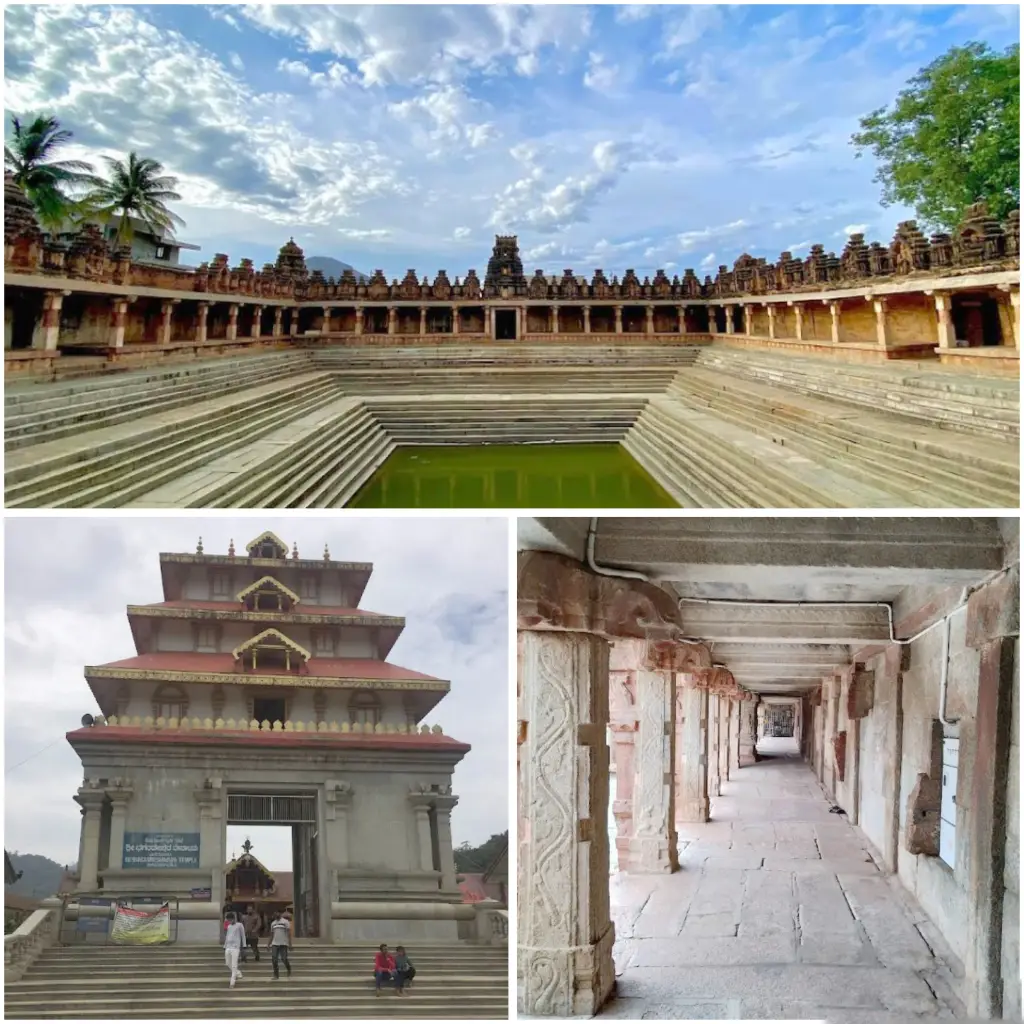
Stories and Beliefs: Myths and Beliefs of the Temple
Temples are not structures; they are sites where individuals get linked to old myths and legends. The Sri Bhoga Nandishwara Gudi also has its own quota of peculiar myths and legends.
One of the chief beliefs is regarding the sacred temple tank, a huge stepped pond outside the primary temple. It’s referred to as a Kalyani or Pushkarni, and here it is also referred to as Sringeri Teertha. They feel that this tank itself is the origin of a sacred river named the Pinakini River. So, a dip in its waters or sprinkling it on oneself is held in high esteem and purifying. When thousands of small oil lamps are burned around the tank during festivals, it is just breathtaking, like a sky filled with stars over water!
Another firm belief, particularly among couples, is about the Uma-Maheshwara shrine. It is also believed, and unanimously so, that praying here will bestow huge boons for a blissful, affluent, and long-lasting married life. Scores of newlywed couples visit from all over to attain these boons immediately after their wedding. It’s as if it’s been a generations-old custom.
There are also local myths regarding the deities’ protective powers in the temple, particularly Lord Nandi, who is said to protect the entire region of Nandi Hills. People believe that through worshipping here, they are protected and prosperous.
Sri Bhoga Nandishwara Temple Timing:
If you’d like to travel to this lovely destination, it’s helpful to know when it’s open! Sri Bhoga Nandishwara Gudi is typically open to visitors and pilgrims from early morning through late evening.
Typically, the temple opens at about 6:00 AM and remains open until roughly 7:00 PM or 8:00 PM. However, similar to most temples, there could be occasional breaks in between, particularly in the afternoon, for rituals or for giving the priests a break.
It’s always best to double-check the timings exactly before you visit, particularly if you are going to go in time for a special festival or during a public holiday, because sometimes timings are altered. But for the most part, if you visit in daylight hours, you’ll discover the temple open and inviting.
Read More>> Sri Vidya Chowdeshwari Temple Hangarahalli
More Adventures Nearby: Places to Visit Near the Temple
Surprise! Your journey doesn’t need to end at the Sri Bhoga Nandishwara Gudi! There are some other quite awesome sites very close by to visit.
Nandi Hills: Directly above the temple are the renowned Nandi Hills themselves! It’s a very crowded area, particularly in the early morning, to view the sunrise. Just imagine the sun coloring the sky with all manner of lovely colors! There are some other small temples and lookouts at the summit of the hills. It’s a perfect location for a short hike or a picnic.
Tipu’s Drop: On Nandi Hills, there is a well-known cliff named Tipu’s Drop. It’s a historical location with an interesting, albeit somewhat sad, tale of a courageous ruler named Tipu Sultan. The scenery from here is simply breathtaking, like being on an airplane and looking down!
Bhoga Nandeeshwara Temple (on Nandi Hills): Confusing, right? There’s another small temple on top of Nandi Hills called Yoganandeeshwara Temple, sometimes also referred to as Bhoga Nandeeshwara (just to make it more fun!). This one is usually less crowded and offers a different kind of peaceful vibe.
Amrita Sarovar: A stunning lake close to the Nandi Hills, which has clear water and peaceful landscapes. It’s a pretty nice place to unwind and soak in nature after visiting the temple.
So, you can spend an entire day there, discovering the temple and then trekking up the hills or to the lake for some more adventure!
Read More>> Swayambhu Nagaraja Temple Bengaluru
Your Journey to the Past: How to Reach the Temple
Getting to Sri Bhoga Nandishwara Gudi is relatively easy! It’s situated in a lovely area of Karnataka, India, not far from the city of Bengaluru (formerly known as Bangalore).
By Road: The most convenient method of reaching there is by taxi or bus. The temple is easily accessible by good roads. If you are approaching from Bengaluru, it is a 60-70 kilometer drive, which would take 1.5 to 2 hours, depending upon the traffic. You may take a taxi, an auto-rickshaw, or even a local bus moving towards Nandi Hills.
Nearest Airport: The nearest large airport is the Kempegowda International Airport (BLR) at Bengaluru. You can readily get taxis from the airport to take you directly to the temple.
Nearest Railway Station: The nearest large railway station is also at Bengaluru. From there, you can get a cab or bus to the temple. There are smaller railway stations nearer by, such as Chikkaballapur, but Bengaluru is generally the most convenient.
Just inform your driver that you’d like to go to “Sri Bhoga Nandishwara Gudi at the foot of Nandi Hills,” and they’ll know precisely where to drop you off!
Still not satisfied with my content? please feel free to visit wikipedia link.




